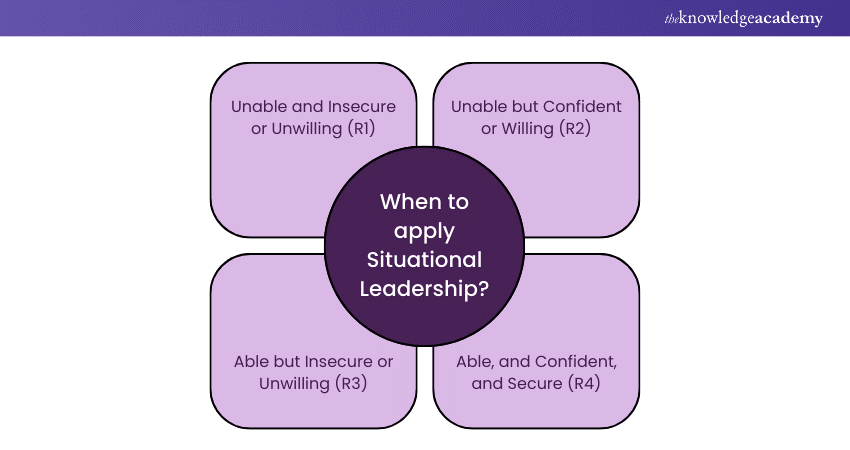We may not have the course you’re looking for. If you enquire or give us a call on +65 6929 8747 and speak to our training experts, we may still be able to help with your training requirements.
Training Outcomes Within Your Budget!
We ensure quality, budget-alignment, and timely delivery by our expert instructors.

Have you ever wondered how some Leaders can manage different situations and people effectively while others struggle to do so? How do they know what to do and how to do it in various circumstances? The answer is that they use Situational Leadership, a style of Leadership that adapts to the changing needs of the team and the environment. In this blog, you will learn What is Situational Leadership, how it works, and why it is essential for Leaders to master it.
Table of Contents
1) Understanding What is Situational Leadership?
2) Which four Situational Leadership types are there?
3) When might Situational Leadership be applied most effectively?
4) How come Situational Leadership works so well?
5) What drawbacks does Situational Leadership have?
6) Conclusion
Understanding What is Situational Leadership?
Situational Leadership, formulated by Paul Hersey and Ken Blanchard in 1969, is a Leadership approach founded on the notion that there isn't a universal best method for leading. Instead, its effectiveness hinges on adapting to the specific situation and individuals involved.
This model isn't static; rather, it offers a flexible and dynamic framework enabling Leaders to tailor their behaviour and strategies to meet the needs of their followers and the demands of various tasks.
Which four Situational Leadership types are there?
According to Hersey and Blanchard, there are four types of Situational Leadership, each with a different combination of directive and supportive behaviours. Directive behaviours provide guidance, direction, and instructions to the followers, while supportive behaviours provide encouragement, feedback, and recognition to the followers. The four types of Situational Leadership are:

Telling (S1)
This type of Leadership is high on directive and low on supportive behaviours. It is used when the followers are unable and unwilling or insecure to perform the task. The Leader tells the followers what to do, how to do it, and when to do it without much explanation or involvement. The Leader makes all the decisions and closely supervises the followers.
This type of Leadership is suitable for situations that require quick and accurate results or when the followers are new or inexperienced.
Selling (S2)
This type of Leadership is high in both directive and supportive behaviours. It is used when the followers are unable but willing or confident to perform the task. The Leader still provides direction and guidance but also explains the reasons and rationale behind the task.
The Leader also encourages and praises the followers for their efforts and involvement. The Leader actively solicits input and feedback from the followers yet retains the authority to make final decisions.
This type of Leadership is suitable for situations that require learning and development or when the followers are motivated but lack the skills or knowledge.
Participating (S3)
This type of Leadership is low on directive and high on supportive behaviours. It is used when the followers are unwilling or insecure to perform the task. The Leader provides less direction and more support, allowing the followers to take more responsibility and initiative for the task.
The Leader facilitates and participates in decision-making but lets the followers have the final say. The Leader also provides emotional and social support, such as listening, empathising, and coaching.
This type of Leadership is suitable for situations requiring commitment and collaboration or when the followers are competent but lack confidence or motivation.
Delegating (S4)
This type of Leadership is low on both directive and supportive behaviours. It is used when the followers are able and willing or confident to perform the task. The Leader delegates the task to the followers, giving them the authority and autonomy to complete it.
The Leader provides minimal guidance and support, only intervening when necessary or requested. The Leader trusts and respects the followers’ abilities and decisions.
This type of Leadership is suitable for situations that require empowerment and innovation or when the followers are experienced and self-reliant.
Equip yourself with the tools and strategies needed to make informed and effective decisions in any situation with our Decision Making Skills Training.
When might Situational Leadership be applied most effectively?
Situational Leadership can be applied most effectively when the Leader can accurately assess the situation and the followers and match the appropriate Leadership style accordingly. The Leader should consider two main factors: the task and the followers. The task refers to the nature, complexity, and urgency of the work.
The followers refer to their level of competence and commitment to the task. Competence is the ability to perform the task, while commitment is the willingness and confidence to perform the task. Based on these factors, the followers can be classified into four levels of readiness:

Unable and Insecure or Unwilling (R1)
These followers have low competence and low commitment. They lack the skills, knowledge, and experience to perform the task and the motivation, confidence, and interest to do so. They need much direction and guidance from the Leader, as well as encouragement and support. The Leader should use the telling style (S1) with these followers.
Unable but Confident or Willing (R2)
These followers have low competence and high commitment. They do not have the skills, knowledge, and experience to perform the task, but they have the motivation, confidence, and interest. They need a lot of direction, guidance from the Leader, and explanation and rationale behind the task. The Leader should use the selling style (S2) with these followers.
Able but Insecure or Unwilling (R3)
These followers have high competence and low commitment. They have the skills, knowledge, and experience to perform the task but lack the motivation, confidence, or interest to do so. They need less direction and guidance from the Leader but more support and involvement. The Leader should use the participating style (S3) with these followers.
Able, and Confident, and Secure (R4)
These followers have high competence and high commitment. They have the skills, knowledge, and experience to perform the task and the motivation, confidence, and interest to do so. They need minimal direction and guidance from the Leader and more autonomy and authority. The Leader should use the delegating style (S4) with these followers.
Enhance your Leadership skills and become a more effective Leader with our specialised Leadership Skills Course. Register Now!
Why does Situational Leadership work so well?
Situational Leadership works so well because it is based on the premise that different situations and people require different types of Leadership. By adapting to the followers' needs and the task's demands, the Leader can achieve the best possible outcomes. Some of the benefits of Situational Leadership are:
a) It increases the effectiveness and efficiency of the Leader and the followers as they work together in a way that suits their strengths and weaknesses.
b) It enhances communication and collaboration between the Leader and the followers as they share information, feedback, and ideas.
c) It improves the motivation and satisfaction of the followers, as they feel valued, respected, and empowered by the Leader.
d) It fosters the learning and development of the followers as they acquire new skills, knowledge, and experience from the Leader and the task.
e) It promotes the Leader's and followers' flexibility and adaptability as they cope with changing and challenging situations.
What drawbacks does Situational Leadership have?
Situational Leadership is not without its drawbacks, however. Some of the challenges and limitations of Situational Leadership are:
a) It requires the Leader to have a high level of self-awareness, emotional intelligence, and situational awareness, as they need to assess the situation and the followers accurately and objectively.
b) It requires the Leader to have a wide range of skills, knowledge, and experience, as they must switch between different Leadership styles and behaviours.
c) It requires the Leader to have high trust and respect from the followers, as they need to influence and persuade them to follow their lead.
d) It requires the Leader to have a clear and consistent vision and goals, as they must align the different Leadership styles and behaviours with the desired outcomes.
d) It may cause confusion and inconsistency among the followers, as they may not understand or appreciate the Leader’s style and behaviour changes.
Transform your Leadership approach and drive success in Agile environments with our Agile Leadership Training. Join today!
Conclusion
Situational Leadership represents a versatile and responsive Leadership approach, allowing Leaders to adjust their methods to suit the needs of their team or individual members. This approach is grounded in the understanding that there isn't a singular best method of Leadership; rather, the most effective style depends on the specific situation and the individuals involved. By using the four types of situational leadership, leaders can match their behaviour and approach to the level of competence and commitment of their followers.
Start your journey towards effective Leadership with our Successful People Management and Team Leadership Course. Sign up now!
Frequently Asked Questions

Situational Leadership adapts to the followers’ needs and abilities. The four styles are telling, selling, participating, and delegating. Each style involves different tasks and relationship behaviour by the Leader.

Steve Jobs, the co-founder of Apple, used different styles of Leadership depending on the situation and the team. He used a telling style for inexperienced or unmotivated employees, a selling style for persuasion and coaching, a participating style for collaboration and feedback, and a delegating style for empowerment and trust.

The Knowledge Academy takes global learning to new heights, offering over 30,000 online courses across 490+ locations in 220 countries. This expansive reach ensures accessibility and convenience for learners worldwide.
Alongside our diverse Online Course Catalogue, encompassing 17 major categories, we go the extra mile by providing a plethora of free educational Online Resources like News updates, Blogs, videos, webinars, and interview questions. Tailoring learning experiences further, professionals can maximise value with customisable Course Bundles of TKA.

The Knowledge Academy’s Knowledge Pass, a prepaid voucher, adds another layer of flexibility, allowing course bookings over a 12-month period. Join us on a journey where education knows no bounds.

The Knowledge Academy offers various Leadership Courses, including Leadership Skills and Agile Leadership Training. These courses cater to different skill levels, providing comprehensive insights into Organisational Leadership.
Our Business Skills blogs cover a range of topics related to Leadership skills and upskilling, offering valuable resources, best practices, and industry insights. Whether you are a beginner or looking to advance your Leadership skills, The Knowledge Academy's diverse courses and informative blogs have you covered.







 Top Rated Course
Top Rated Course




 If you wish to make any changes to your course, please
If you wish to make any changes to your course, please


